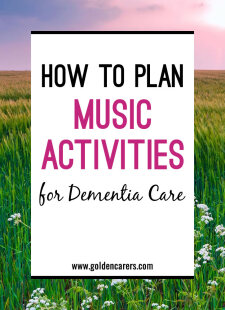Shared By
Molly
 Activity Professional & Writer
Activity Professional & Writer
Reminiscing: How to Create a Memory Board

Residents downsize quite a bit to move into a care home. Help them reminisce about their past while you learn more about them by creating memory boards!
Creating a memory board is a project that incorporates arts and crafts, reminiscing and 1:1 time. Memory boards are a great way to get to know more about residents and a fabulous activity for family members and other staff members to get involved with.
Memory Boards are a Person-Centered Activity
This project is an enjoyable way for Activity Professionals to incorporate another person-centered activity into their program.
Memory Boards are unique for each resident. Be sure to ask for the resident’s input each step of the way – from what color they want their poster board, to what images are included.
How to Incorporate Reminiscing into the Activity
Reminiscing is a fun and engaging activity for seniors, particularly for residents with dementia or Alzheimer’s. Before you get started, ask yourself, is the resident drawn to a specific period?
For example, are they always asking to go home? What home are they referring to i.e., their childhood home? Create a board dedicated to this period of their life. Include pictures of their home (if they have any) or ask specific questions like what color house was it? Did you get along with your neighbors?
A memory board is a great opportunity to learn more about this time in the residents’ life. Learning more about this time of their lives will even allow you to reminisce with them later when they bring it up again.
Supplies You Will Need
- Poster board
- Scissors
- Glue or Tape
- Scrapbook Material
- Markers or Sharpies
- Magazines for clipping (Reminisce Magazine and Good Old Days Magazine are good resources)
- Resident-specific photographs and memorabilia
Interview Questions to Ask Each Resident
Create a sheet with a list of questions to ask each resident:
- Where did you grow up?
- Do you have a nickname?
- What is your favorite hobby?
- What did you do for a living?
- Where did you get married?
- What was your first car?
- Where did you go to school?
- What significant historical event occurred in your life?
Directions
A Memory Board may take a couple of days to set up and complete. Take time and have fun with this project!
Session One
- Set up all the supplies around the arts and crafts table.
- Invite a group of residents to take part in the activity.
- Have each resident sort through the supplies and choose which they would like to use on their poster board.
- Keep all their supplies together in a bag or folder with the resident’s name on them, so that you have easy access to them at the next session.
Session Two
- Ask residents to bring pictures or memorabilia they would like included on the board.
- With all the supplies gathered, have the residents start decorating the board.
- Once the resident is happy with the design either glue or tape each item in its place.
Session Three
- Display the completed boards around the Activities room.
- Invite residents, family, and staff to see the boards.
Invite Other Departments to be Involved
Activity Professionals are not the only staff members who benefit from learning more about the residents in their care. Invite other departments to join in during a specific part of the project, even if it is only for 15 minutes so that they have a chance to get to know the residents a bit better, too.
You may ask them to conduct the interviews or ask for their help to sort through the resident’s photographs. No matter which part, ensure that you encourage staff to spend some time with the resident.
As staff and residents get to know each other on a personal level the quality of care improves. It is in encouraging these types of relationships that we can work to bring about culture change.
Invite Family Members to be Involved
Most family members look for ways to stay active in their loved one’s care, but sometimes they don’t know where to begin. Inviting family members to become involved in this project can be a fun bonding experience between them and the resident.
Even family members who live far away can take part in this fun activity! They will no doubt have a ton of pictures they could send you and may even have a funny story they think should be added to the board.
As well, residents who have Aphasia or who are not able to answer your questions can still participate in the project if Activities Professionals call up the family to ask them the questions on the interview sheet.
Related: Aphasia Activity Ideas
Hold a Gala in their Honor
The fun doesn’t have to stop when the boards are complete! When the Boards are finished, invite all the residents, families, and staff to attend a Gala opening where the boards are displayed.
Serving sparkling cider and light refreshments will delight those in attendance and dignify the event and the residents who are presenting. The residents are sharing a glimpse of their lives with the community, which should be encouraged and respected by anyone who attends.
A Fun Activity for All
Creating a Memory Boards is a fun activity that allows residents to shine as individuals. This activity includes arts and crafts, a 1:1 activity, reminiscing and can even be considered as a large group activity if you choose to hold a Gala at the end.






I am sure our seniors will enjoy this Thanksgiving Bingo,just like the really enjoy playing the Travel, Sightseeing and other great Bingo. I am excited to play the Dice Bingo, am am sure our men will like it. Thanks for the easy to use and inexpensive resources for our seniors.
What I love about these cards is that you can use them for bingo but so many more things like matching and reminiscing just to name a few
i'm going to start this this week!
At our Day Center for seniors we decided one year to give them each an individual memory frame. We asked them questions about their past, their pastimes, their favorite things , then we asked them to bring old pictures of themselves that we scanned and later on printed, we also found images pertinent to their comments and made them each their own memory board as their Christmas gift. It was a very long process since we had about 100 to make, our fingers were all glued up, but in the end to see their faces at Christmas was priceless. Very nice gift to make!
Sounds great Karine
wow am so impressed,i wish to try this on our diary ;down the memory line on sundays.thank you so much
I am glad you like this
It would be great if you let us know how your project turned out
Thank you
This is a great program to do leading into July 1st new standards, person centred care is what it's all about, I love the idea of other staff being involved gleaning the information to get to know their residents
I have done a sunflower picture for each of my residents in the memory unit and have put information from their Life Story on each petal..it is then laminated and placed near the door so that staff can instantly see the information about the resident...it is like their story in a nutshell. I will now further this by doing the poster boards, love this idea.
This is a lovely idea Joanne!
On one of my units, I do something similar to this but I place them in a shadow box in each patients room. I ask a variety of questions and then I type the questions and the patients answers up adding pictures of relative things from their answers and place them in their shadow box. Then patients and families can add pictures and fun things from home in the shadow box too. Staff Love them as the information is great conversation starters especially for folks that are quiet and maybe having a difficult time adjusting or socializing with others!
Great idea Donna
Two of my residents familys did something similar to this and typed out a sheet of facts:
My name is xyz: and I was born in 1346
'Important steps in my life'
they then listed the steps chronologically eg
1974 Sold my house in Baxter Avenue
1976 my daughter, Anne, was born
this sheet of facts is so much help to the dementia resident who continually asks the same question, where is this place, have you seen my dog, etc. we read through the sheet and explain they have probably forgotten because that happens when you get older. Straight away they feel less anxious.
Good idea Jean
This memory board is also good to decrease problem behaviors https://www.goldencarers.com/how-to-decrease-problem-behaviors/5056/ because a resident can be brought to a quiet area with the board and a staff member before the behavior becomes problematic
Talking about the memory board will probably redirect and refocus the residents attention to what is on board and hopefully they will forget what upset them in the first place
A board like this is especially helpful to those who have dementia. If it is in a residents room, it can start discussions with staff and visitors.
Remind all that you never ask a resident with dementia "Do you remember?"
Instead say "Tell me about"
Molly shared a new article: Reminiscing: How to Create a Memory Board